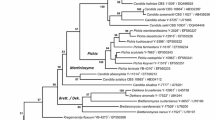Abstract
Twelve strains representing five novel yeast species were isolated from natural samples distributed in mountain areas in Taiwan during 2007 and 2009. Sequence analysis of the D1/D2 domain of the large subunit (LSU) rRNA gene revealed that these species are members of the Cyberlindnera clade. These five new species have a greater than 1% difference from their closest relatives in the sequences of the D1/D2 domain of the LSU rRNA gene and were well separated from their closest relatives in terms of physiological characteristics. Moreover, a sexual state could not be found in these five novel yeast species. Therefore, the scientific names of Candida maesa sp. nov. (type strain GJ8L01T), Candida takata sp. nov. (type strain EN25S01T), Candida taoyuanica sp. nov. (type strain GY15S07T), Candida hungchunana sp. nov. (type strain NC3W71T) and Candida stauntonica sp. nov. (type strain GY13L05T) were proposed to accommodate these yeasts.


Similar content being viewed by others
References
Chen B, Huang X, Zheng JW, Li SP, He J (2009) Candida mengyuniae sp. nov., a metsulfuron-methyl-resistant yeast. Int J Syst Evol Microbiol 59:1237–1241
Felsenstein J (1995) Confidence limits on phylogenies: an approach using the bootstrap. Evolution 39:783–791
Jindamorakot S, Am-in S, Thuy TT, Duy ND, Kawasaki H, Potacharoen W, Limtong S, Tanticharoen M, Nakase T (2004) Candida easanensis sp. nov., Candida pattaniensis sp. nov. and Candida nakhonratchasimensis sp. nov., three new species of yeasts isolated from insect frass in Thailand. J Gen Appl Microbiol 50:261–269
Kurtzman CP (2000) Four new yeasts in the Pichia anomala clade. Int J Syst Evol Microbiol 50:395–404
Kurtzman CP (2011) Lindnera Kurtzman, Robnett, Basehoar-Powers (2008). In: Kurtzman CP, Fell JW, Boekhout T (eds) The yeasts, a taxonomic study, 5th edn. Elsevier, Amsterdam, pp 521–543
Kurtzman CP, Robnett CJ (1995) Molecular relationship among hyphal ascomycetous yeasts and yeast like taxa. Can J Bot 73:824–830
Kurtzman CP, Robnett CJ (1997) Identification of clinically important ascomycetous yeasts based on nucleotide divergence in the 5′ end of the large subunit (26s) ribosomal DNA gene. J Clin Microbiol 35:1216–1223
Kurtzman CP, Robnett CJ (1998) Identification and phylogeny of ascomycetous yeasts from analysis of nuclear large subunit (26S) ribosomal DNA partial sequences. Anton van Leeuwenhoek 73:331–371
Kurtzman CP, Robnett CJ, Basehoar-Powers E (2008) Phylogenetic relationships among species of Pichia, Issatchenkia and Williopsis determined from multigene sequence analysis, and the proposal of Barnettozyma gen. nov., Lindnera gen. nov. and Wickerhamomyces gen. nov. FEMS Yeast Res 8:939–954
Kurtzman CP, Fell JW, Boekhout T, Robert V (2011a) Methods for isolation, phenotypic characterization and maintenance of yeasts. In: Kurtzman CP, Fell JW, Boekhout T (eds) The yeasts, a taxonomic study, 5th edn. Elsevier, Amsterdam, pp 137–144
Kurtzman CP, Fell JW, Boekhout T (2011b) Gene sequence analyses and other DNA-based methods for yeast species recognition. In: Kurtzman CP, Fell JW, Boekhout T (eds) The yeasts, a taxonomic study, 5th edn. Elsevier, Amsterdam, pp 137–144
Lachance M-A, Boekhout T, Scorzetti G, Fell JW, Kurzman CP (2011) Candida Berkhout (1923). In: Kurtzman CP, Fell JW, Boekhout T (eds) The yeasts, a taxonomic study, 5th edn. Elsevier, Amsterdam, pp 987–1278
Lee CF, Liu CH, Young SS, Chang KS (2008) Kazachstania jiainicus sp. nov., an ascomycetous yeast species isolated from soil in Taiwan. FEMS Yeast Res 8:114–118
Liu CH, Young SS, Chang TC, Lee CF (2008) Candida dajiaensis sp. nov., Candida yuanshanicus sp. nov., Candida jianshihensis sp. nov., and Candida sanyiensis sp. nov., four anamorphic, ascomycetous yeast species isolated from soil in Taiwan. FEMS Yeast Res 8:815–822
Liu YR, Huang LY, Young SS, Chang CF, Lee CF (2011) Asterotremella meifongana sp. nov. and Asterotremella nantouana sp. nov., two anamorphic basidiomycetous yeasts isolated from soil and mushrooms. Anton van Leeuwenhoek 99:643–650
Mestre MC, Rose CA, Fontenla SB (2011) Lindnera rhizosphaerae sp. nov., a yeast species isolated from rhizospheric soil. Int J Syst Evol Microbiol 61:985–988
Minter DW (2009) Cyberlindnera, a replacement name for Lindnera Kurtzman et al., nom. Illegit. Mycotaxon 110:473–476
Shenoy BD, Jeewon R, Hyde KD (2007) Impact of DNA sequence-data on the taxonomy of anamorphic fungi. Fungal Divers 26:1–54
Tamura K, Peterson D, Peterson N, Stecher G, Nei M, Kumar S (2011) MEGA5: molecular evolutionary genetics analysis using maximum likelihood, evolutionary distance, and maximum parsimony methods. Mol Biol Evol 28:2731–2739
Thompson JD, Gibson TJ, Plewniak F, Jeanmougin F, Higgins DG (1997) The CLUSTAL_X windows interface: flexible strategies for multiple sequence alignment aided by quality analysis tools. Nucleic Acids Res 25:4876–4882
Wang SA, Bai FY (2010) Lindnera wuzhiensis sp. nov., a novel ascomycetous yeast species. J Gen Appl Microbiol 56:409–412
White TJ, Bruns T, Lee S, Taylor J (1990) Amplification and direct sequencing of fungal ribosomal RNA genes for phylogenetics. In: Innis MA, Gelfand DH, Sninsky JJ, White TJ (eds) PCR protocols: a sequencing guide to methods and applications. Academic Press, San Diego, pp 315–322
Acknowledgments
This work was supported by a Taiwan-Russia joint Grant-in-Aid from the National Science Council (NSC), Executive Yuan, Taiwan (NSC 99-2923-B-134-001-MY3), and Russian Foundation for Basic Research (RFBR), Russia (No.10-04-92008). The authors thank Dr. Shing-Fan Huang and Dr. Edelgard Fu-Tschin Tschen for identification of plants and mushrooms as samples in this study, respectively.
Author information
Authors and Affiliations
Corresponding author
Rights and permissions
About this article
Cite this article
Chang, CF., Liu, YR., Chen, SF. et al. Five novel species of the anamorphic genus Candida in the Cyberlindnera clade isolated from natural substrates in Taiwan. Antonie van Leeuwenhoek 102, 9–21 (2012). https://doi.org/10.1007/s10482-012-9708-0
Received:
Accepted:
Published:
Issue Date:
DOI: https://doi.org/10.1007/s10482-012-9708-0




